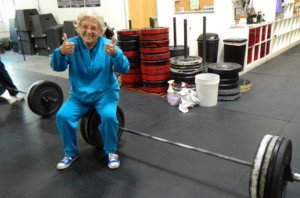
If elderly people could choose just one exercise to maintain fitness and vitality, which would it be, the most important of all?
It is lifting weights. Only 10 to 15 percent of “old people” lift weights.
Yet another study shows how valuable lifting weights (aka strength training) is for the aging population.
The June 2011 issue of Deutsches Ärzteblatt International has the full report, but in summary, lifting weights opposes muscle shrinkage and deterioration in elderly people.
Why so few elderly actually train with weights can be in part explained by fear of breaking a bone, as well as belief that they’re too weak to even do any such training. Bones break when they become brittle (aside from traumatic injury).
Strength training increases bone density, making them less vulnerable to breaking.

The “V-taper” body signifies fitness. Shutterstock/Monkey Business Images
Elderly people need to get this simple fact, and start hitting the gym.
The German study involved subjects over 60 years.
Not surprisingly, the findings were that strength training increased not only muscle strength, but caused adaptation in the bones and tendons.
The stress of resistance against the bones and tendons forces these structures to adapt:
They become stronger. Sitting in a chair all day does not force the body to become stronger and more efficient.
The study also found that the greater the weightlifting intensity, the greater the results.

Sharon Smith, 71
So if a senior citizen has been lifting weights for a while and has some basic conditioning, he or she should up the ante and bring on a little more intensity.
It’s also safe for seniors to use weights three to four times a week. But never work the same muscle group two days in a row.
An elderly person can begin strength training in her own home simply by repeatedly sitting up and down from a chair.
This is a bodyweight exercise and will strengthen the legs and hips. Sit in a stable chair and stand up without pushing off the arm rests with the hands … if this is possible. Then do this for up to 12-20 repetitions.
If all you can do is five, then start with five. If you need to push off with your hands, then do that minimally with the goal of no longer needing to do that.
You can also do this exercise off of a higher chair which will be easier.
Lifting soup cans is another start. Tension tubing can be used for all sorts of strength training moves.
Weighted balls and small dumbbells can be used. In other words, even a homebound hermit with a fear of open spaces can still do strength training.
Sharon Smith has been in the fitness industry for 25+ years and specializes in the over-40 client.
 Lorra Garrick is a former personal trainer certified through the American Council on Exercise. At Bally Total Fitness she trained women and men of all ages for fat loss, muscle building, fitness and improved health.
Lorra Garrick is a former personal trainer certified through the American Council on Exercise. At Bally Total Fitness she trained women and men of all ages for fat loss, muscle building, fitness and improved health.









































